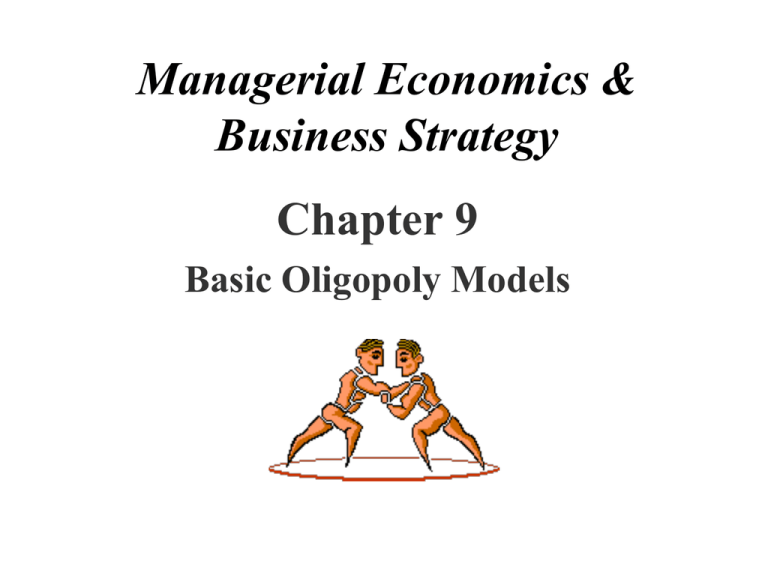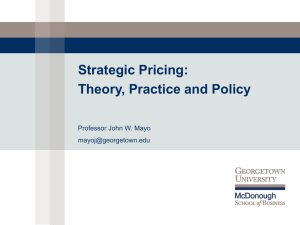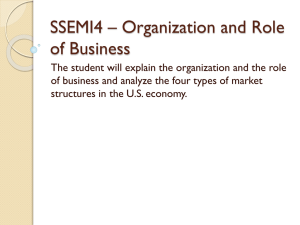Chapter 9
advertisement

Managerial Economics & Business Strategy Chapter 9 Basic Oligopoly Models Oligopoly • Relatively few firms, usually less than 10. n n Duopoly - two firms Triopoly - three firms • The products firms offer can be either differentiated or homogeneous. • Firms behave strategically • Barriers to entry exist • “Let’s Play Oligopoly” WSJ, 1999 Role of Strategic Interaction • What you do affects the profits of your rivals • What your rival does affects your profits • Strategic interdependence: You aren’t in complete control of your own destiny! Cournot Model • • • • • A few firms produce goods that are either perfect substitutes (homogeneous) or imperfect substitutes (differentiated) Firms set output, as opposed to price. Each firm decides “how much” given its beliefs about the output of the other firm. Barriers to entry exist Example: Oil production. Each firm produces output independently and the market price is determined by the total amount produced. Reaction Functions • Suppose two firms produce homogeneous products. • Firm 1’s reaction (or best-response) function is a schedule summarizing the amount of Q1 firm 1 should produce in order to maximize its profits given each quantity of Q2 produced by firm 2. • Since the products are substitutes, an increase in firm 2’s output leads to a decrease in the profitmaximizing amount of firm 1’s product. Cournot Equilibrium • Situation where each firm produces the output that maximizes its profits, given the the output of rival firms • No firm can gain by changing its own output Cournot Equilibrium and Selecting Profit-Maximizing Q • From inverse demand, find MR for each firm • Set MR = MC • Solve for each firms reactions functions: Q1(Q2) and Q2(Q1). • Graph each firm’s reaction function (Q1 on x-axis and Q2 on y-axis, for example). Cournot Equilibrium and Selecting Profit-Maximizing Q Situation: United Airlines and American Airlines fly passengers between Chicago and LA. Assume no other company can enter because they can’t get landing rights at both airports. Facts: Marginal Costs: MCAA = MCUA = $147/passenger. Market Demand: Q = 339 – P or P = 339 – Q, where Q = QAA + QUA; Thus, P = 339 – QAA – QUA Cournot and Profit-Maximizing Q To maximize profits, each firm chooses Q at the level in which MR=MC. You can either find an expression for TR for firm i, then differentiate with respect to Qi. This will give each firm’s MR function. Alternatively, you can use the fact that MR has twice the slope of inverse demand function! Marginal Costs: MCAA = MCUA = $147/passenger. P = 339 – QAA – QUA, so TRAA = 339QAA – QAA2 – QUAQAA TRUA = 339QUA – QUA2 – QAAQUA MRAA = 339 – 2QAA – QUA and MRUA = 339 – QAA – 2QUA For AA: 339 – 2QAA – QUA = 147 and solve for QAA. AA Rxn Func: QAA = 96 – 0.5QUA UA Rxn Func: QUA = 96 – 0.5QAA Cournot Equilibrium and Selecting Profit-Maximizing Q To find Cournot Equilibrium (also a Nash equilibrium), plug one firm’s rxn function into the other firm’s. QAA = 96 – 0.5(96 - 0.5QAA), and solving for QAA = 64. Plug QAA = 64 into UA rxn function. QUA = 64. This outcome is due to the fact that MC are the same for both firms. Cournot Equilibrium QUA 192 rAA Cournot Equilibrium 96 64 48 rUA 64 96 192 QAA Collusion If UA and AA collude, then see monopoly outcome. MR = 339 – 2Q. Set MR=MC, 339 – 2Q = 147, Q = 96, where UA and AA split the passengers. P = 339 – Q, P = $243 versus $211 if competing duopoly Cournot Equilibrium QUA Collusion: each produce 48 & each would earn greater profits, but likely not sustainable. 192 rAA Cournot Equilibrium 96 64 48 rUA 64 96 192 QAA Stackelberg Model • Few firms n • • Barriers to entry Firm one is the leader n • The leader commits to an output before all other firms Remaining firms are followers. n • Producing differentiated or homogeneous products They choose their outputs so as to maximize profits, given the leader’s output. Example: Diamond production. DeBeers is the leader that sets diamond production, and smaller firms follow with their own levels of production. Stackelberg Oligopoly • Assume AA has first-mover advantage; thus, picks output before UA. • UA still has a rxn function, but AA doesn’t. • AA plugs UA rxn function into its TR function. • Find AA MR function (differentiate TR) • Set MRAA = MCAA, solve for QAA. • Plug QAA into UA’s rxn function and get QUA Stackelberg Oligopoly • Recall, UA’s rxn function is QUA = 96 – 0.5QAA • TRAA = 339QAA – (96 – 0.5QAA)QAA – QAA2 • MRAA = 339 – 96 + QAA – 2QAA • MRAA = 243 – QAA • Set MRAA = MC, 243 – QAA = 147 QAA = 96 Therefore QUA = 48 and P = $195 Stackelberg Summary • Leader produces more than the Cournot equilibrium output n n Larger market share, higher profits First-mover advantage • Follower produces less than the Cournot equilibrium output n Smaller market share, lower profits Bertrand Model • Few firms n n • • Barriers to entry Consumers enjoy n n • Firms produce identical products at constant marginal cost. Each firm independently sets its price in order to maximize profits Perfect information Zero transaction costs Example: Competitive bidding by identical contractors. In this case, the contractor bidding the lowest fee will win the contract. Bertrand Equilibrium • Firms set P1 = P2 = MC! Why? • Suppose MC < P1 < P2 • Firm 1 earns (P1 - MC) on each unit sold, while firm 2 earns nothing • Firm 2 has an incentive to slightly undercut firm 1’s price to capture the entire market • Firm 1 then has an incentive to undercut firm 2’s price. This undercutting continues... • Equilibrium: Each firm charges P1 = P2 =MC Comparing Oligopoly Models • Cournot: n n P = $211 Profits for each firm = $4096 (= 211*64 – 147*64) • Stackelberg: n n P = $195 (lower than Cournot because Q higher) Profits for AA = $4608 and $2304 for UA. • Collusion n n P = $243 Profits for each firm = $4608 • Bertrand: n n P= $147 Profits for each firm = $0 Contestable Markets • Key Assumptions of Contestable Markets n n n n Producers have access to same technology Consumers respond quickly to price changes Existing firms cannot respond quickly to entry by lowering price Absence of sunk costs • Key Implications of Contestable Markets n n Threat of entry disciplines firms already in the market Incumbents have no market power, even if there is only a single incumbent (a monopolist) • Note: if existing firms can respond quickly, then may keep new entrants out. Contestable Markets • Video rentals: In 1998, who did you rent movies from? • Netflix enters 1999! • http://digitalenterprise.org/cases/netflix.html Summary • Different oligopoly scenarios give rise to different optimal strategies and different outcomes • Your optimal price and output depends on … n n n Beliefs about the reactions of rivals Your choice variable (P or Q) and the nature of the product market (differentiated or homogeneous products) Your ability to commit










